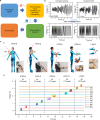Low cost exoskeleton manipulator using bidirectional triboelectric sensors enhanced multiple degree of freedom sensory system
- PMID: 33976216
- PMCID: PMC8113469
- DOI: 10.1038/s41467-021-23020-3
Low cost exoskeleton manipulator using bidirectional triboelectric sensors enhanced multiple degree of freedom sensory system
Abstract
Rapid developments of robotics and virtual reality technology are raising the requirements of more advanced human-machine interfaces for achieving efficient parallel control. Exoskeleton as an assistive wearable device, usually requires a huge cost and complex data processing to track the multi-dimensional human motions. Alternatively, we propose a triboelectric bi-directional sensor as a universal and cost-effective solution to a customized exoskeleton for monitoring all of the movable joints of the human upper limbs with low power consumption. The corresponding movements, including two DOF rotations of the shoulder, twisting of the wrist, and the bending motions, are detected and utilized for controlling the virtual character and the robotic arm in real-time. Owing to the structural consistency between the exoskeleton and the human body, further kinetic analysis offers additional physical parameters without introducing other types of sensors. This exoskeleton sensory system shows a great potential of being an economic and advanced human-machine interface for supporting the manipulation in both real and virtual worlds, including robotic automation, healthcare, and training applications.
Conflict of interest statement
M.Z., Z.S., and C.L. are inventors on patent application (pending, Ref: 2021-019) submitted by National University of Singapore, that covers exoskeleton manipulator with the bidirectional triboelectric sensors enabled sensory system. The remaining author declares no competing interests.
Figures






Similar articles
-
Modifying upper-limb inter-joint coordination in healthy subjects by training with a robotic exoskeleton.J Neuroeng Rehabil. 2017 Jun 12;14(1):55. doi: 10.1186/s12984-017-0254-x. J Neuroeng Rehabil. 2017. PMID: 28606179 Free PMC article.
-
Design of a 6-DOF upper limb rehabilitation exoskeleton with parallel actuated joints.Biomed Mater Eng. 2014;24(6):2527-35. doi: 10.3233/BME-141067. Biomed Mater Eng. 2014. PMID: 25226954
-
Gravity compensation of an upper extremity exoskeleton.Annu Int Conf IEEE Eng Med Biol Soc. 2010;2010:4489-93. doi: 10.1109/IEMBS.2010.5626036. Annu Int Conf IEEE Eng Med Biol Soc. 2010. PMID: 21095778
-
Application of EMG signals for controlling exoskeleton robots.Biomed Tech (Berl). 2006 Dec;51(5-6):314-9. doi: 10.1515/BMT.2006.063. Biomed Tech (Berl). 2006. PMID: 17155866 Review.
-
A review of methods for achieving upper limb movement following spinal cord injury through hybrid muscle stimulation and robotic assistance.Exp Neurol. 2020 Jun;328:113274. doi: 10.1016/j.expneurol.2020.113274. Epub 2020 Mar 5. Exp Neurol. 2020. PMID: 32145251 Review.
Cited by
-
A Self-Powered Flexible Displacement Sensor Based on Triboelectric Effect for Linear Feed System.Nanomaterials (Basel). 2023 Dec 7;13(24):3100. doi: 10.3390/nano13243100. Nanomaterials (Basel). 2023. PMID: 38132996 Free PMC article.
-
Advanced Implantable Biomedical Devices Enabled by Triboelectric Nanogenerators.Nanomaterials (Basel). 2022 Apr 15;12(8):1366. doi: 10.3390/nano12081366. Nanomaterials (Basel). 2022. PMID: 35458075 Free PMC article. Review.
-
Towards next generation digital twin in robotics: Trends, scopes, challenges, and future.Heliyon. 2023 Feb 9;9(2):e13359. doi: 10.1016/j.heliyon.2023.e13359. eCollection 2023 Feb. Heliyon. 2023. PMID: 36825188 Free PMC article. Review.
-
Wearable Triboelectric Sensors Enabled Gait Analysis and Waist Motion Capture for IoT-Based Smart Healthcare Applications.Adv Sci (Weinh). 2022 Feb;9(4):e2103694. doi: 10.1002/advs.202103694. Epub 2021 Nov 19. Adv Sci (Weinh). 2022. PMID: 34796695 Free PMC article.
-
Heterogeneous Wafer Bonding Technology and Thin-Film Transfer Technology-Enabling Platform for the Next Generation Applications beyond 5G.Micromachines (Basel). 2021 Aug 11;12(8):946. doi: 10.3390/mi12080946. Micromachines (Basel). 2021. PMID: 34442568 Free PMC article. Review.
References
-
- Niyetkaliyev AS, Hussain S, Ghayesh MH, Alici G. Review on design and control aspects of robotic shoulder rehabilitation orthoses. IEEE Trans. Hum.-Mach. Syst. 2017;47:1134–1145. doi: 10.1109/THMS.2017.2700634. - DOI
-
- Polygerinos P, et al. Soft robotics: review of fluid-driven intrinsically soft devices; manufacturing, sensing, control, and applications in human-robot interaction. Adv. Eng. Mater. 2017;19:1700016. doi: 10.1002/adem.201700016. - DOI
Publication types
MeSH terms
LinkOut - more resources
Full Text Sources
Other Literature Sources

